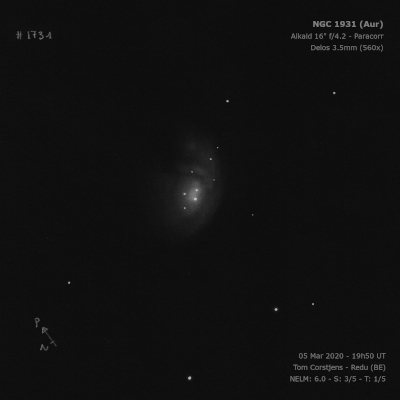
William Herschel discovered NGC 1931 = H I-261 = h355 on 4 Feb 1793 (sweep 1030) and recorded "vB, irr R, vgbM, about 4 or 5' diameter. Seems to have 1 or 2 stars in the middle or an irregular nucleus; the chevelure diminishes very gradually." On 5 Jan 1827 (sweep 42), John Herschel reported "a triple star in a nebula. A most curious object. The nebula surrounds the stars like an atmosphere."
The observers using Lord Rosse's 72" reported 5 to 6 stars were involved on various nights. The first observation was made by Johnstone Stonney on 29 Nov 1848, though he only noted "saw a multitude of stars and some unresolved nebulositiy."
200/250mm - 8" (11/8/80): compact, striking nebulosity involving several stars.
300/350mm - 13" (11/5/83): five stars involved including three close fairly bright stars. A fourth very faint star to the west, fifth very faint star NE and sixth extremely faint star west. This is a bright, high surface brightness nebulosity.
400/500mm - 17.5" (2/8/86): five stars including ADS 4112 (mag 11.5/12.3/13 at 8" and 10") are located within a bright, small nebulosity of high surface brightness. A sixth very faint star is just outside the nebula. Dims with OIII filter.
Notes by Steve Gottlieb